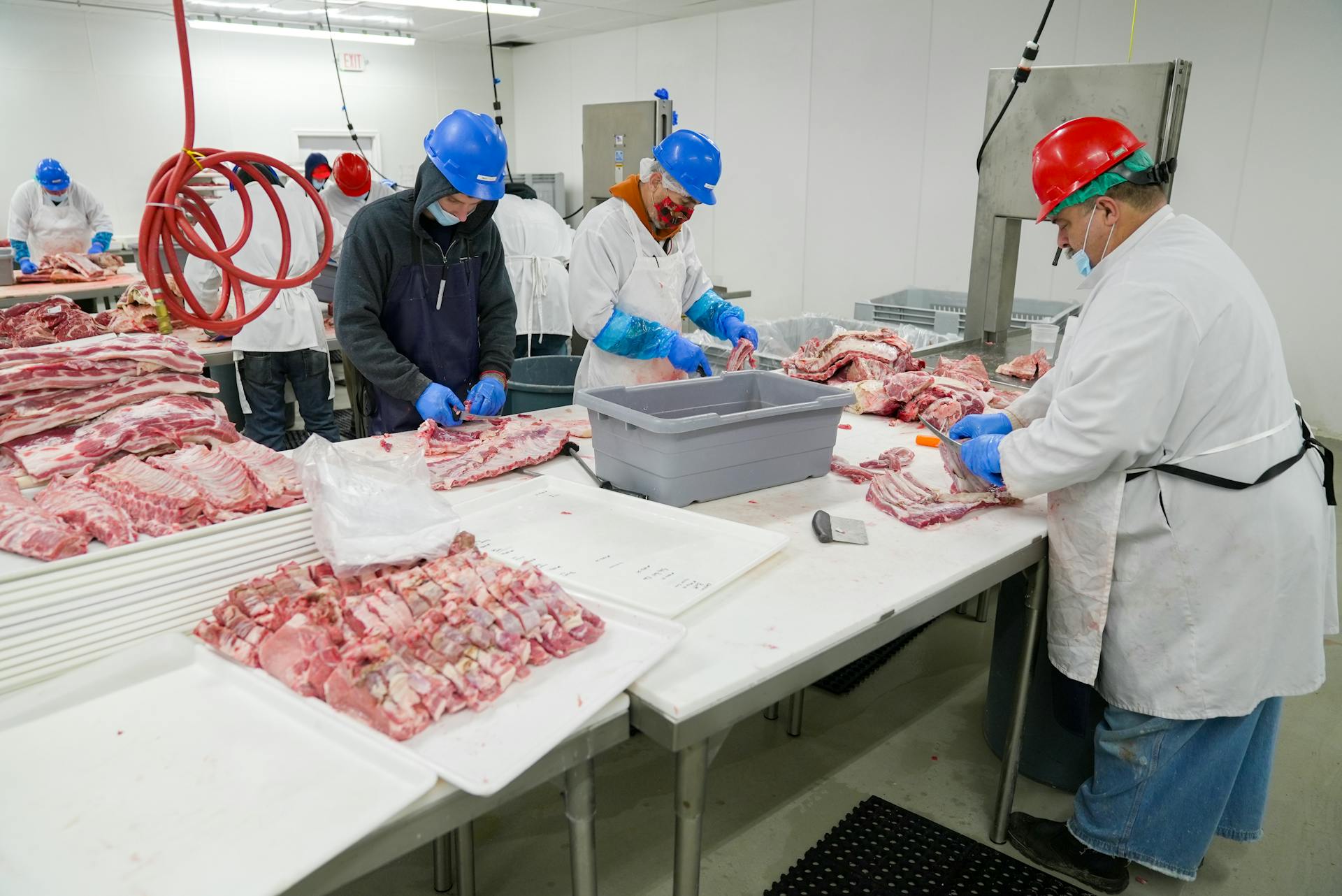
The USDA Home Loan program offers several benefits to eligible borrowers. It provides 100% financing, meaning you can purchase a home with no down payment.
To be eligible, you must have a moderate income and purchase a home in a rural area. The USDA defines rural areas as those outside of cities and towns with a population of 35,000 or less.
The loan has a low interest rate, which can save you money on your mortgage payments. This can be a significant advantage for first-time homebuyers.
Types of USDA Loans
There are three types of USDA home loans, each with its own unique benefits and requirements.
The USDA guarantees a mortgage issued by a participating local lender, allowing borrowers to qualify for low mortgage interest rates without a down payment. This typically costs less than traditional PMI.
Direct loans are issued by the USDA and are for low- and very low-income applicants who are without safe housing or can’t access a traditional home loan. Income thresholds vary by region.
Home improvement loans and grants are available to homeowners to repair or upgrade their homes. Loans are capped at $40,000, while grants have a maximum of $10,000.
The USDA usually issues direct loans for homes with a market value below the area loan limit, which can be as high as $700,000 in pricey real estate markets like California and Hawaii.
Here are the key characteristics of each type of loan:
Borrowers should note that direct loans also offer terms of up to 38 years, and home improvement loans and grants can combine a loan and a grant, providing up to $50,000 in total assistance.
Mortgage Qualification
To qualify for a USDA home loan, you'll need to meet certain income and credit requirements. Income limits vary by location and household size, and can't exceed 115% of the median income in the county where your new house is located.
You'll also need to have a proven history of dependable income and a credit history that demonstrates a reliable ability to repay debts. A credit score of at least 640 is required for streamlined processing, but borrowers without credit history can be evaluated through alternative criteria.
Here are the key income and credit requirements:
- Income limit: 115% of median income in the county
- Proven history of dependable income
- Minimum credit score: 640 for streamlined processing
- Alternative criteria for borrowers without credit history
The monthly payment on the loan, including principal, interest, insurance, and taxes, must be 29% or less of your monthly income. Other monthly debt payments can't exceed 41% of your income.
Eligibility and Requirements
To qualify for a USDA home loan, you must meet certain requirements. You must have an income that does not exceed 115% of the median income for the area.
To qualify for a USDA direct home loan, a borrower must meet more specific requirements, including having income at or below the low-income limit for the area and not being able to obtain a mortgage from other sources.
The home must be located in a USDA-approved area, which is typically a rural area but can also include towns and suburbs with a population of under 35,000. You can check if a house is in an eligible area by typing the address into the USDA property eligibility map.
To see a summary of the eligibility requirements, here's a breakdown:
Eligibility Requirements
To qualify for a USDA home loan, you'll need to meet certain eligibility requirements. You must have an income that does not exceed 115% of the median income for the area.
The property must be located in a rural area with a population of 35,000 or less. This can include towns and suburbs that meet the USDA's eligibility criteria.
To be eligible for a USDA loan, you must be a U.S. citizen, U.S. resident, or qualified alien. You must also agree to use the home as your primary residence.
Here are the income limits for different types of USDA loans:
A credit score of at least 640 is ideal for a USDA guaranteed loan, but you may still qualify if your score is lower. A debt-to-income ratio of 41% or less is also preferred, with your monthly mortgage payment not exceeding 29% of your monthly income.
You must also have the legal capacity to enter a loan contract and not be debarred from participating in federal programs.
Community Financing

Rural America's charm is undeniable, with its wide-open spaces and tight-knit communities. The USDA Guaranteed Rural Development Program is a game-changer for rural residents, creating opportunities for affordable housing and robust community services.
Life in rural areas can be rewarding, but access to affordable housing can be challenging. The USDA Guaranteed Rural Development Program helps bridge this gap.
Rural residents can thrive with the right financing options, and the USDA Guaranteed Rural Development Program is designed to make homeownership a reality.
What Are the Advantages?
One of the biggest advantages of USDA home loans is that no down payment is required. This makes them an excellent choice for those with limited savings.
USDA loans are backed by the government, which means lenders take on less risk. This can help first-time homebuyers who haven't saved up a lot yet. Lower interest rates are another perk, with interest on USDA loans substantially lower than conventional mortgages.

Income limits vary by location and number of people within your household, and your household must fall into the USDA's income limits for your area. A reasonably good credit score is still vital, usually a score of 660 or higher is a good guideline, but lower scores can be accepted with strong compensating factors.
USDA loans are more forgiving than conventional loans, with flexible credit requirements. No mortgage insurance is required, which can save you a significant amount of money. You can also avoid paying mortgage insurance premiums, which can top 2% and typically have to be paid until you reach 20% home equity.
Here are some of the key advantages of USDA home loans:
- 100% financing with zero down
- No cash reserve requirements
- Low, fixed-interest rate
- Seller can pay the closing costs
- Easier qualifying credit guidelines
- Can use the mortgage to build or renovate a home
- Can roll repairs and renovations into the mortgage
- No pre-payment penalties
Application Process
The application process for a USDA home loan can seem daunting, but don't worry, I'm here to break it down for you. First, you'll need to determine if you're eligible for a USDA loan by checking the income eligibility chart on the USDA website.

To qualify, you'll need to meet the eligibility criteria and be in a USDA-qualified rural area. This means you'll need to find a property that meets the program's safety and sanitary standards. You can do this by researching the USDA's list of approved lenders and shopping around to make sure you get the best loan terms.
Once you've found a lender, you'll need to submit an application and documentation, including proof of income, bank statements, and other paperwork. If you're not approved, you can try applying for a USDA direct loan through the USDA's Rural Development office.
Here are the steps to follow:
- Determine Eligibility: Check the income eligibility chart on the USDA website.
- Find a Lender: Research the USDA's list of approved lenders and shop around for the best loan terms.
- Submit Application: Complete your application and documentation, including proof of income and bank statements.
- Apply for a Direct Loan: If you're not approved, try applying for a USDA direct loan through the USDA's Rural Development office.
Remember, the key to a successful application is to be prepared and patient. By following these steps and doing your research, you'll be well on your way to securing your USDA home loan.
Lenders and Options
If you're looking for lenders that offer USDA loans, you're in luck because there are a few options available.

Guild Mortgage is one such option that stands out from the rest. They offer fixed-rate and adjustable-rate USDA loans, and you can even apply online for rates. They also have a wide range of loan options, including conventional loans, construction loans, and jumbo loans.
PNC Bank is another lender that offers USDA loans, with a $5,000 grant for low-income borrowers who qualify for a USDA direct loan. They also have a Home Insight Planner on their website that can help you get a clear picture of your financial standing and find houses that fit your budget.
Here are some key features of USDA loan lenders:
Fees
Fees can add up quickly, but understanding what you're getting into can help you plan. The upfront guarantee fee for USDA loans is 1% of your total loan amount, which means if you borrow $150,000, your total amount would be $151,500.
This fee functions similarly to mortgage insurance, but it's a bit more straightforward. For a $150,000 loan, the annual fee would add about $44.19 to your monthly mortgage payment.
USDA loans don't have private mortgage insurance, which can be a significant savings. However, the upfront guarantee fee and annual fee are two main fees attached to USDA loans.
Best Mortgage Lenders

When choosing a mortgage lender, it's essential to consider your options carefully. Guild Mortgage is one of the standout picks for USDA loans, offering flexible credit score requirements and nontraditional credit history acceptance.
Guild Mortgage will approve USDA loans for borrowers with credit scores as low as 540, well below the 640 required by most lenders. This can be a game-changer for those with thin or nonexistent credit records.
Guild Mortgage has earned a reputation for excellent customer service, including an A+ from the Better Business Bureau and the second-highest score in J.D. Power's 2023 U.S. Mortgage Servicer Satisfaction Study.
Flagstar Bank Loans is another option to consider, offering a wide range of mortgage products, including USDA loans. They issue USDA loans in all 50 US states and have a user-friendly website with an online application portal.
Flagstar Bank Loans has physical branches in only nine states, but their website makes it easy to get personalized rates and complete most of the closing process on your mobile device or desktop.

Here are some key features of the lenders mentioned:
Ultimately, the best mortgage lender for you will depend on your individual circumstances and needs. It's essential to research and compare different options to find the one that works best for you.
PNC Bank
PNC Bank offers a range of mortgage options, including fixed-rate and adjustable-rate mortgages, as well as conventional loans, FHA loans, VA loans, USDA loans, jumbo loans, HELOCs, Community Loan, and Medical Professional Loan.
Their mortgage terms range from 10 to 30 years, and they consider credit scores as low as 620.
PNC Bank's online application process allows you to apply for personalized rates and manage your application securely through their tracker feature.
If you qualify for a USDA direct loan, PNC Bank offers a $5,000 grant for low-income borrowers that can be put toward closing costs or other prepaid fees.
Their Home Insight Planner tool provides a clear picture of your financial standing and helps you find houses that meet your budget.
Here are some of the mortgage options available at PNC Bank:
- Conventional loans
- FHA loans
- VA loans
- USDA loans
- Jumbo loans
- HELOCs
- Community Loan
- Medical Professional Loan
Geographic and Regional Information
You can find eligible areas for a USDA loan in Utah by using the property eligibility lookup tool on the USDA website or by zooming in on the U.S. map to see general areas of eligibility.
Much of Utah is located in eligible areas, except for a large region stretching along U.S. 89, I-15, and I-84, which includes cities like Provo, Salt Lake City, Ogden, and Layton.
If you're looking for a home in Summit County, you'll be happy to know that nearly all of it, including Heber and Park City, are eligible areas for USDA home loans, except for a small area along I-215 around Emigration Canyon.
Utah County Boundaries
The corridor formed by Highway 6, I-15, and U.S. 89 in Utah County is surrounded by ineligible regions for USDA loans. This includes the cities of Provo, Orem, Lindon, and a swath that extends to the western boundary of Utah Lake.
Properties located in Utah County on the eastern side of Utah Lake are eligible for USDA loans. The ineligible region also extends to the west to Uintah National Forest.
In Utah County, the following cities are not eligible for rural loans from the USDA:
- Provo
- Orem
- Lindon
Weber County Boundaries
Weber County is located in the north-central part of Utah and is home to several towns, including Ogden, North Ogden, Eden, and Huntsville.
The county is bounded by I-15 to the east, where it meets the Great Salt Lake, and by U.S. 89 to the west, where it meets the surrounding mountains.
Properties east of I-15 are generally ineligible for certain loans, such as USDA loans.
However, the mountainous areas west of U.S. 89 are eligible, including the towns of Eden and Huntsville and the surrounding rural landscape.
These boundaries can impact where you can buy or build a home, so it's essential to understand them if you're considering moving to Weber County.
Washington County
Washington County is home to the St. George metropolitan area, which is unfortunately not eligible for USDA loans.
The ineligible region extends through Santa Clara, but don't worry, Ivins and areas west of it are still eligible.
The I-15 corridor is also not eligible, running from the south county line north until after Washington.
If you're looking to buy a home in the area, you'll be happy to know that areas north and west of St. George, including the towns of Hurricane and La Verkin, are eligible for USDA loans.
The surrounding rural regions of these towns are also eligible, making them great options for those looking for a rural lifestyle.
Frequently Asked Questions
How long is an USDA loan for?
USDA loans can have repayment periods of up to 38 years for eligible applicants. This long repayment period can help make homeownership more affordable.
What is the disadvantage of USDA loans?
USDA loans have strict eligibility requirements and come with lifetime mortgage insurance premiums, which may limit their availability to some borrowers.
Sources
Featured Images: pexels.com

